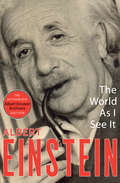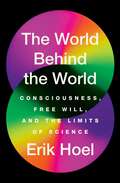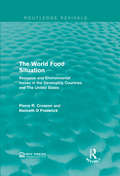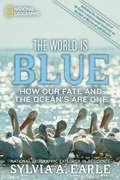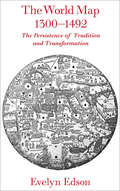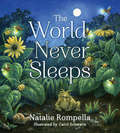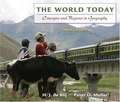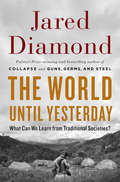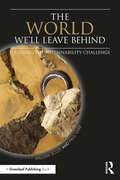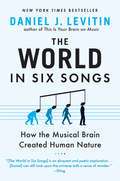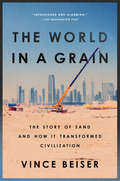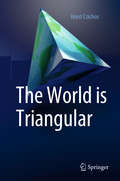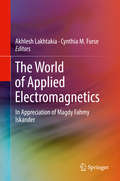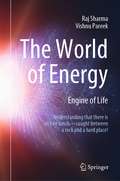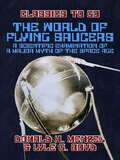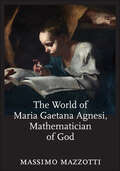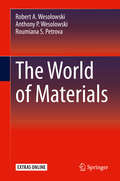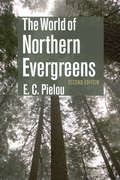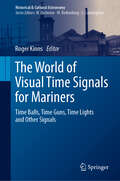- Table View
- List View
The World As I See It (Deluxe Hardbound Edition Ser.)
by Albert EinsteinOne of the world&’s greatest minds addresses religion and science, war and peace, and the treatment of minorities in this authorized collection. In the aftermath of the First World War, Albert Einstein writes about his hopes for the League of Nations, his feelings as a German citizen about the growing anti-Semitism and nationalism of his country, and his myriad opinions about the current affairs of his day. In addition to these political perspectives, The World As I See It reveals the idealistic, spiritual, and witty side of this great intellectual as he approaches topics including &“Good and Evil,&” &“Religion and Science,&” &“Active Pacifism,&” &“Christianity and Judaism,&” and &“Minorities.&” Including letters, speeches, articles, and essays written before 1935, this collection offers a complete portrait of Einstein as a humanitarian and as a human being trying to make sense of the changing world around him. This authorized ebook features a new introduction by Neil Berger, PhD, and an illustrated biography of Albert Einstein, which includes rare photos and never-before-seen documents from the Albert Einstein Archives at the Hebrew University of Jerusalem.
The World As I See It (Deluxe Hardbound Edition Ser.)
by Albert EinsteinOne of the world&’s greatest minds addresses religion and science, war and peace, and the treatment of minorities in this authorized collection. In the aftermath of the First World War, Albert Einstein writes about his hopes for the League of Nations, his feelings as a German citizen about the growing anti-Semitism and nationalism of his country, and his myriad opinions about the current affairs of his day. In addition to these political perspectives, The World As I See It reveals the idealistic, spiritual, and witty side of this great intellectual as he approaches topics including &“Good and Evil,&” &“Religion and Science,&” &“Active Pacifism,&” &“Christianity and Judaism,&” and &“Minorities.&” Including letters, speeches, articles, and essays written before 1935, this collection offers a complete portrait of Einstein as a humanitarian and as a human being trying to make sense of the changing world around him. This authorized ebook features a new introduction by Neil Berger, PhD, and an illustrated biography of Albert Einstein, which includes rare photos and never-before-seen documents from the Albert Einstein Archives at the Hebrew University of Jerusalem.
The World Before Us: The New Science Behind Our Human Origins
by Tom HighamA fascinating investigation of the origin of humans based on incredible new discoveries and advanced scientific technology Fifty thousand years ago, Homo sapiens was not the only species of humans in the world. There were also Neanderthals in what is now Europe, the Near East, and parts of Eurasia; Hobbits (H. floresiensis) on the island of Flores in Indonesia; Denisovans in Siberia and eastern Eurasia; and H. luzonensis in the Philippines. Tom Higham investigates what we know about these other human species and explores what can be learned from the genetic links between them and us. He also looks at whether H. erectus may have survived into the period when our ancestors first moved into Southeast Asia. Filled with thrilling tales of recent scientific discoveries, this book offers an engaging synopsis of our current understanding of human origins and raises new and interesting possibilities—particularly concerning what contact, if any, these other species might have had with us prior to their extinction.
The World Behind the World: Consciousness, Free Will, and the Limits of Science
by Erik HoelA fascinating exploration into how the brain creates our conscious experiences—potentially revolutionizing neuroscience and the future of technology—from a Forbes 30 Under 30 scientist.Throughout history, two perspectives on the world have dueled in our minds: the extrinsic—that of mechanism and physics—and the intrinsic—that of feelings, thoughts, and ideas. The intrinsic perspective allows us to tell stories about our lives, to chart our anger and our lust, to understand our psychologies. The extrinsic allows us to chart the physical world, to build upon it, and to travel across it. These perspectives have never been reconciled; they almost seem to exist on different planes of thought. Only recently, due to the pioneering work of DNA-discoverer Francis Crick, have these two perspectives been conjoined. This attempt to reconcile these perspectives is the science of consciousness, and posits that the intrinsic aspect of the world, how and what we perceive, can coexist in the extrinsic part of the world, in the realm of physics. The World Behind the World is a grand tour of the state of this science, an exploration of the point where tectonic metaphysical forces meet, often in paradoxical conclusions. Forbes 30 Under 30 scientist Dr. Erik Hoel lays out the evidence that nothing in the brain makes sense except in the light of a theory of consciousness. Some topics he examines include what the similarities are between our brains and black holes; where consciousness fits into physics and morality; and why it may be impossible for AI to ever become conscious, despite popular belief. The World Behind the World argues that establishing a proven theory of consciousness would trigger a paradigm shift in the field of neuroscience and the future of technology—transforming the very fabric of our society. What does the science of consciousness tell us about what happens beyond brain death? Does our understanding of consciousness strengthen or weaken the case for free will? Is science itself incomplete in the way Gödel showed mathematics is? By taking us through the heated debates of the field and drawing on Hoel&’s own original research to shed light on the latest theories about how the brain creates consciousness, The World Behind the World shows us that at long last, science is coming to understand the fundamental mystery of human existence.
The World Food Situation: Resource and Environmental Issues in the Developing Countries and The United States (Routledge Revivals)
by Pierre R. Crosson Kenneth D FrederickAt the beginning of the 1970’s, global grain reserves were level and food prices were low however as the decade progressed crop production plummeted leading to a food crisis. Originally published in the aftermath in 1977, Crosson and Frederick set out to explore the ability of agricultural output to meet the global food demands of future generations. This study analyses how resources and environmental factors would affect food production in developing countries and the United States until the end of the 21st Century. The environmental impacts of land levels, fertiliser and pesticide use are explored in relation to the challenges of meeting food demands. This title will be of interest to students of environmental studies.
The World Is Blue: How Our Fate and the Ocean's Are One
by Sylvia A. EarleExplorer-in-residence at the National Geographic Society, oceanographer Earle adds blue to the green movement by explaining the importance of the earth's ocean to the health of its life. She begins by setting out the conventional vision of the ocean's limitless bounty for harvesting wildlife and infinite resiliency as the ultimate garbage disposal. Then she explains how the ocean is suffering from biodiversity loss, drilling, mining, shipping, spilling, and changing climate and chemistry. The final section surveys opportunities for reversing the tide by exploring and governing the ocean, smart aquaculture, and protective measures. Annotation c2009 Book News, Inc., Portland, OR (booknews.com)
The World Map, 1300–1492: The Persistence of Tradition and Transformation
by Evelyn EdsonA history of the development of world maps during the later medieval period in the centuries leading up to Columbus’s journey.In the two centuries before Columbus, mapmaking was transformed. The World Map, 1300–1492 investigates this important, transitional period of mapmaking. Beginning with a 1436 atlas of ten maps produced by Venetian Andrea Bianco, Evelyn Edson uses maps of the fourteenth and fifteenth centuries to examine how the discoveries of missionaries and merchants affected the content and configuration of world maps.She finds that both the makers and users of maps struggled with changes brought about by technological innovation?the compass, quadrant, and astrolabe?rediscovery of classical mapmaking approaches, and increased travel. To reconcile the tensions between the conservative and progressive worldviews, mapmakers used a careful blend of the old and the new to depict a world that was changing?and growing?before their eyes.This engaging and informative study reveals how the ingenuity, creativity, and adaptability of these craftsmen helped pave the way for an age of discovery.“A comprehensive and complex picture of the changing face of medieval geography. With the mastery of a formidable palette of historiographic knowledge and well-reasoned discussions of the sources, The World Map, 1300–1492 will certainly remain an important work to consult for both medieval and early modern scholars for many years to come.” —Ian J. Aebel, Terrae Incognitae
The World Never Sleeps (Tilbury House Nature Book #0)
by Carol Schwartz Natalie RompellaMidnight. Stars speckle the darkness with bits of light. A cockroach skitters across the kitchen floor to snatch a forgotten breadcrumb. In the backyard, a spider weaves an intricate design on the fence. Winged insects dance and flicker in the porch light. Day and night, small creatures are busy working, eating, hunting, hiding. This nonfiction picture book reveals the hidden lives of insects and other small creatures from one midnight to the next. The world may appear to be sleeping in the dead of night, but it is not. As moonflowers open and stars shine, nature goes about her business. The world never sleeps. Natalie Rompella’s lyrical text is vividly complemented by Carol Schwartz’s watercolors. A cat roams through the illustrations—silent witness, in the house and in the yard, to the myriad lives of night and day. A sense of mystery pervades all—even the backmatter natural-history portraits of the animals met in the book. This nature book invites children into a parallel universe, one that teems with life while they sleep. Lexile Level 700; F&P Level O
The World Of Animals (God's Design For Life)
by Debbie Lawrence Richard LawrenceYou will explore every facet of the animal kingdom in this book. From cuddly mammals and slimy frogs, to jellyfish and bacteria, you and your child will discover how God created each animal to be unique. The activities make learning about animals even more fun.
The World Today: Concepts and Regions in Geography
by Peter O. Muller Eugene Joseph Palka H. J. de BlijTextbook on the geography of the world toward the close of the first decade of the twenty-first century as well as a guide to geographic ideas and perspectives, past and present.
The World Until Yesterday: What Can We Learn from Traditional Societies?
by Jared DiamondThe bestselling author of Collapse and Guns, Germs and Steel surveys the history of human societies to answer the question: What can we learn from traditional societies that can make the world a better place for all of us?<P> Most of us take for granted the features of our modern society, from air travel and telecommunications to literacy and obesity. Yet for nearly all of its six million years of existence, human society had none of these things. While the gulf that divides us from our primitive ancestors may seem unbridgeably wide, we can glimpse much of our former lifestyle in those largely traditional societies still or recently in existence. Societies like those of the New Guinea Highlanders remind us that it was only yesterday—in evolutionary time—when everything changed and that we moderns still possess bodies and social practices often better adapted to traditional than to modern conditions.The World Until Yesterday provides a mesmerizing firsthand picture of the human past as it had been for millions of years—a past that has mostly vanished—and considers what the differences between that past and our present mean for our lives today.<P> This is Jared Diamond’s most personal book to date, as he draws extensively from his decades of field work in the Pacific islands, as well as evidence from Inuit, Amazonian Indians, Kalahari San people, and others. Diamond doesn’t romanticize traditional societies—after all, we are shocked by some of their practices—but he finds that their solutions to universal human problems such as child rearing, elder care, dispute resolution, risk, and physical fitness have much to teach us. Provocative, enlightening, and entertaining, The World Until Yesterday is an essential and fascinating read.
The World We'll Leave Behind: Grasping the Sustainability Challenge
by William Scott Paul VareIt is now clear that human activity has influenced how the biosphere supports life on Earth, and given rise to a set of connected environmental and social problems. In response to the challenge that these problems present, a series of international conferences and summits led to discussions of sustainable development and the core dilemma of our time: How can we all live well, now and in the future, without compromising the ability of the planet to enable us all to live well? This book identifies the main issues and challenges we now face; it explains the ideas that underpin them and their interconnection, and discusses a range of strategies through which they might be addressed and possibly resolved. These cover things that governments might do, what businesses and large organisations can contribute, and the scope for individuals, families and communities to get involved. This book is for everyone who cares about such challenges, and wants to know more about them.
The World in Six Songs: How the Musical Brain Created Human Nature
by Daniel J. LevitinThe author of the New York Times bestseller This Is Your Brain on Music reveals music's role in the evolution of human culture-and "will leave you awestruck" (The New York Times)Daniel J. Levitin's astounding debut bestseller, This Is Your Brain on Music, enthralled and delighted readers as it transformed our understanding of how music gets in our heads and stays there. Now in his second New York Times bestseller, his genius for combining science and art reveals how music shaped humanity across cultures and throughout history. Dr. Levitin identifies six fundamental song functions or types-friendship, joy, comfort, religion, knowledge, and love-then shows how each in its own way has enabled the social bonding necessary for human culture and society to evolve. He shows, in effect, how these "six songs" work in our brains to preserve the emotional history of our lives and species. Dr. Levitin combines cutting-edge scientific research from his music cognition lab at McGill University and work in an array of related fields; his own sometimes hilarious experiences in the music business; and illuminating interviews with musicians such as Sting and David Byrne, as well as conductors, anthropologists, and evolutionary biologists. The World in Six Songs is, ultimately, a revolution in our understanding of how human nature evolved-right up to the iPod.Read Daniel Levitin's posts on the Penguin Blog.
The World in Six Songs: How the Musical Brain Created Human Nature
by Daniel J. LevitinThe author of the New York Times bestseller This Is Your Brain on Music reveals music's role in the evolution of human culture-and "will leave you awestruck" (The New York Times)Daniel J. Levitin's astounding debut bestseller, This Is Your Brain on Music, enthralled and delighted readers as it transformed our understanding of how music gets in our heads and stays there. Now in his second New York Times bestseller, his genius for combining science and art reveals how music shaped humanity across cultures and throughout history. Dr. Levitin identifies six fundamental song functions or types-friendship, joy, comfort, religion, knowledge, and love-then shows how each in its own way has enabled the social bonding necessary for human culture and society to evolve. He shows, in effect, how these "six songs" work in our brains to preserve the emotional history of our lives and species. Dr. Levitin combines cutting-edge scientific research from his music cognition lab at McGill University and work in an array of related fields; his own sometimes hilarious experiences in the music business; and illuminating interviews with musicians such as Sting and David Byrne, as well as conductors, anthropologists, and evolutionary biologists. The World in Six Songs is, ultimately, a revolution in our understanding of how human nature evolved-right up to the iPod.Read Daniel Levitin's posts on the Penguin Blog.
The World in Six Songs: How the Musical Brain Created Human Nature
by Daniel J. LevitinThe author of the New York Times bestseller This Is Your Brain on Music reveals music's role in the evolution of human culture-and "will leave you awestruck" (The New York Times)Daniel J. Levitin's astounding debut bestseller, This Is Your Brain on Music, enthralled and delighted readers as it transformed our understanding of how music gets in our heads and stays there. Now in his second New York Times bestseller, his genius for combining science and art reveals how music shaped humanity across cultures and throughout history. Dr. Levitin identifies six fundamental song functions or types-friendship, joy, comfort, religion, knowledge, and love-then shows how each in its own way has enabled the social bonding necessary for human culture and society to evolve. He shows, in effect, how these "six songs" work in our brains to preserve the emotional history of our lives and species. Dr. Levitin combines cutting-edge scientific research from his music cognition lab at McGill University and work in an array of related fields; his own sometimes hilarious experiences in the music business; and illuminating interviews with musicians such as Sting and David Byrne, as well as conductors, anthropologists, and evolutionary biologists. The World in Six Songs is, ultimately, a revolution in our understanding of how human nature evolved-right up to the iPod.Read Daniel Levitin's posts on the Penguin Blog.
The World in a Grain: The Story of Sand and How It Transformed Civilization
by Vince BeiserThe gripping story of the most important overlooked commodity in the world--sand--and the crucial role it plays in our lives.After water and air, sand is the natural resource that we consume more than any other--even more than oil. Every concrete building and paved road on Earth, every computer screen and silicon chip, is made from sand. From Egypt's pyramids to the Hubble telescope, from the world's tallest skyscraper to the sidewalk below it, from Chartres' stained-glass windows to your iPhone, sand shelters us, empowers us, engages us, and inspires us. It's the ingredient that makes possible our cities, our science, our lives--and our future.And, incredibly, we're running out of it.The World in a Grain is the compelling true story of the hugely important and diminishing natural resource that grows more essential every day, and of the people who mine it, sell it, build with it--and sometimes, even kill for it. It's also a provocative examination of the serious human and environmental costs incurred by our dependence on sand, which has received little public attention. Not all sand is created equal: Some of the easiest sand to get to is the least useful. Award-winning journalist Vince Beiser delves deep into this world, taking readers on a journey across the globe, from the United States to remote corners of India, China, and Dubai to explain why sand is so crucial to modern life. Along the way, readers encounter world-changing innovators, island-building entrepreneurs, desert fighters, and murderous sand pirates. The result is an entertaining and eye-opening work, one that is both unexpected and involving, rippling with fascinating detail and filled with surprising characters.
The World is Triangular
by Horst CzichosThis book gives a short presentation of the triad philosophy–physics–technology against the background of the common origin in ancient times. The emergence of the book has been described in the foreword of the first edition. The present second edition of the book is updated and extended, whereby new physical research results and technological innovations were included: - The physics of space and time after the experimental detection of gravitational waves (Nobel Prize for Physics 2017). - The New International System of Units (SI) for Physics and Technology which is completely based on natural constants and entered into force on World Metrology Day, 20 May 2019. - Actual overview of basic technologies: Material, Energy, Information. - Technologies for the “Digital World” of information and communication. - Mechatronic and Cyber-physical systems for Industry 4.0. The significance of technology for the world in the 21st century is discussed in the final section of the book.
The World of Applied Electromagnetics
by Akhlesh Lakhtakia Cynthia M. FurseThis book commemorates four decades of research by Professor Magdy F. Iskander (Life Fellow IEEE) on materials and devices for the radiation, propagation, scattering, and applications of electromagnetic waves, chiefly in the MHz-THz frequency range as well on electromagnetics education. This synopsis of applied electromagnetics, stemming from the life and times of just one person, is meant to inspire junior researchers and reinvigorate mid-level researchers in the electromagnetics community. The authors of this book are internationally known researchers, including 14 IEEE fellows, who highlight interesting research and new directions in theoretical, experimental, and applied electromagnetics.
The World of Energy: Engine of Life
by Raj Sharma Vishnu PareekThis book analyzes the entire spectrum of energy, from conventional sources to various alternative sources. Historically, the Sun has been viewed as the ultimate source of energy on the Earth. All forms of energy – fossil fuels and renewables alike – owe their existence to the Sun. The book also provides a historical perspective on energy policy over the years. It explains the fundamentals of energy and all related aspects using clear and straightforward language, and will serve as a reference guide for all stakeholders including policymakers, academics, students and world citizens in general.
The World of Flying Saucers A Scientific Examination of a Major Myth of the Space Age (Classics To Go)
by Donald H. MenzelExcerpt: "Both as scientists and as devotees of science fiction, we have long been interested in space travel. When reports of unidentified flying objects began to increase in the years between 1947 and 1952, one of us (D.H.M.) collected and studied the limited information available about the sightings. He soon concluded (with a slight feeling of disappointment!) that the flying saucers were not vehicles from other worlds but were only mundane objects and events of various kinds, some of them commonplace, some familiar chiefly to meteorologists, physicists, and astronomers."
The World of Kew
by Carolyn FryWithout plants, there would be no life on earth. Kew Gardens is famous for its breathtaking displays of flowers and tree,s but this World Heritage Site is also a globally important scientific and historical organization. Scientists and gardeners use the plants and knowledge that have been collected at Kew since the eighteenth century to advance understanding of the earth's environment and of how plant lfe can be used for human benefit. Published to accompany the ten-part BBC2 series A New Year at Kew, this fascinating book takes us behind the scenes to show the extraordinary range of work carried out at Kew Gardens and Wakehurst Place - home to the Millenium Seed Bank - and by Kew staff overseas. From using forensic botant to micropagating plants facing extinction, from investigating herbal cures from Alzheimer's disease to replanting the volcano-ravaged island of Montserrat, the book shows us aspects of Kew's work that are largely hidden from view abut the benefits of which are far reachingl In the process it provides an absorbing and accessible introduction to such topical subjects as biodiversity, practical conservation and economic botany. Lavishly illustrated and filled with engrossing stories and engaging characters, this book brings to life the world of Kew and the global importance of its work.
The World of Maria Gaetana Agnesi, Mathematician of God (Johns Hopkins Studies in the History of Mathematics #2)
by Massimo MazzottiThe fascinating true story of mathematician Maria Agnesi.She is best known for her curve, the witch of Agnesi, which appears in almost all high school and undergraduate math books. She was a child prodigy who frequented the salon circuit, discussing mathematics, philosophy, history, and music in multiple languages. She wrote one of the first vernacular textbooks on calculus and was appointed chair of mathematics at the university in Bologna. In later years, however, she became a prominent figure within the Catholic Enlightenment, gave up academics, and devoted herself to the poor, the sick, the hungry, and the homeless. Indeed, the life of Maria Agnesi reveals a complex and enigmatic figure—one of the most fascinating characters in the history of mathematics. Using newly discovered archival documents, Massimo Mazzotti reconstructs the wide spectrum of Agnesi's social experience and examines her relationships to various traditions—religious, political, social, and mathematical. This meticulous study shows how she and her fellow Enlightenment Catholics modified tradition in an effort to reconcile aspects of modern philosophy and science with traditional morality and theology.Mazzotti's original and provocative investigation is also the first targeted study of the Catholic Enlightenment and its influence on modern science. He argues that Agnesi's life is the perfect lens through which we can gain a greater understanding of mid-eighteenth-century cultural trends in continental Europe.
The World of Materials
by Robert A. Wesolowski Anthony P. Wesolowski Roumiana S. PetrovaThe world of materials is exciting because new materials are evolving daily. After an introduction to materials science, the book addresses the classification and structure of matter. It moves on to discuss crystal and mechanical properties. Next, the book employs various materials such as semiconductors and iron wires to teach concepts such as electrical conductivity, heat conductivity and allotropes. Corrosion is addressed and a chapter dedicated to interpretation of graphs and diagrams in materials science is presented. The book then progresses with chapters on ceramics, biomaterials, polymers and composites. To address the growing importance of recycling materials, polymer identification codes are explained. Interesting topics such as accidental materials discovery and materials failure are included. Each chapter ends with a chapter summary and questions and answers. Illustrations and worked examples are provided throughout. A lab manual is included as well.Presents an broad overview of materials science topics, including such topics as: crystal and mechanical properties of materials, semiconductors and iron wires, corrosion, ceramics, biomaterials, polymers, and composite materials;Examines modern-day materials, their synthesis, properties, alteration, and applications;Includes supplemental material, such as a lab manual and examples.
The World of Northern Evergreens
by E. C. PielouPraise for the first edition—"This book is guaranteed to enrich the reader's next forest visit."—Library Journal"Pielou's book brings forest ecology to naturalists, bird lovers, hikers, cyclists, canoeists, skiers, mountaineers, and back-country campers."—Seattle Post-Intelligencer"It is E. C. Pielou's contention that evergreen forests... are taken for granted and rarely well understood. To remedy this, the distinguished biogeographer has written a book focusing on the northern evergreen forests. This is a book that many naturalists, both novice and experienced, will read with pleasure and interest."—Canadian Field-Naturalist "Pielou makes a strong, irrefutable, case for the preservation of old-growth forests and wilderness. Anyone who appreciates the outdoors should have this book and take its message to heart."—Forest Planning Canada Global warming and human-driven impacts from logging, natural gas drilling, mining of oil sands, and the development of hydropower increasingly threaten North America's northern forests. These forests are far from being a uniform environment; close inspection reveals that the conifers that thrive there—pines, larches, spruces, hemlocks, firs, Douglas-firs, arborvitaes, false-cypresses, junipers, and yews—support a varied and complex ecosystem. In The World of Northern Evergreens, the noted ecologist E. C. Pielou introduces the biology of the northern forests and provides a unique invitation to naturalists, ecologists, foresters, and everyone living in northern North America who wants to learn about this unique and threatened northern world and the species that make it their home. Through identification keys, descriptions, and life histories of the conifer tree species, the author emphasizes how different these plants are both biologically and evolutionarily from the hardwoods we also call "trees." Following this introduction to the essential conifers, the author's perceptive insights expand to include the interactions of conifers with other plants, fungi, mammals, birds, and amphibians. The second edition, enriched by new illustrations by the author of woodland features and creatures, updates the text to include new topics including mycorrhizal fungi, soil, woodlice, bats, and invasive insects such as the hemlock woolly adelgid. Emphasis is given to the very real human-driven impacts that threaten the species that live in and depend on the vital and complex forest ecosystem. Pielou provides us with a rich understanding of the northern forests in this work praised for its nontechnical presentation, scientific objectivity, and original illustrations.
The World of Visual Time Signals for Mariners: Time Balls, Time Guns, Time Lights and Other Signals (Historical & Cultural Astronomy)
by Roger KinnsThis book describes the worldwide evolution of land-based visual time signals that were used by mariners in the nineteenth and twentieth centuries for accurate navigation at sea. They followed development of chronometers which were carried in ships to show mean time at Greenwich, the chosen prime meridian. Greenwich time could be compared with local astronomical time to determine longitude, but chronometers were mechanical devices that had to be checked for accuracy. Land-based signals that were regulated by astronomical observations evolved from the ideas in 1818 of Robert Wauchope, a British naval officer who served at the Cape of Good Hope. He inspired introduction of time balls, specifically the time ball at Greenwich in 1833 which set the standard for subsequent installations and is still in operation today. The main emphasis is on the external appearance of time signals at different locations around the world and how they were used by mariners for rating chronometers. Time balls and guns also became popular signals for public use and workplace control but then had social and political implications.
